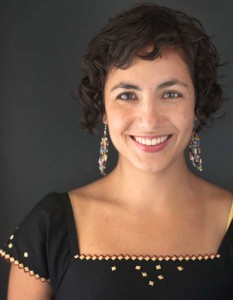
Photo by Christopher McLallen
Mexico City-native Paulina Reyes seeks to promote social change by making the world more beautiful. Reyes said that growing up in Mexico gives her a passion for bold colors and intuitive design, as well as a cultural connection to the craft. She was formerly the art director of Kate Spade New York and led industrial and graphic design for Victoria’s Secret Beauty packaging before landing at the advertising firm, Mother.
Her sustainable handbag designs for Kate Spade are featured in “Design for a Living World,” a traveling exhibit organized by the Nature Conservancy and the Cooper-Hewitt National Design Museum. In 2008, Reyes traveled to Bolivia to work with local craftspeople to create handbags using sustainable wood, cotton and a fiber from leaves of the Jipijapa palm tree manufactured by women in the forest’s indigenous communities. Starting Jan. 16, the exhibit will be on display at the Desert Botanical Garden in Phoenix.
Here, Reyes discusses how sustainability is a humanitarian issue for her, which makes her work more socially than environmentally driven.
What do you say when people ask you, “What do you do?”
My answer is always the same: “I’m a designer.” When people ask me what kind of designer I am, I laugh, scratch my head and say it depends on the job I have at the moment or on the particular project I’m working on.
Design has always been a multi-disciplinary profession for me. Since I was in university, I refused to specialize and decided to immerse myself in the areas of product design, graphic design and illustration. My whole career has been about creating work that blurs the borders between these disciplines and hopefully has an effect on people at an emotional level.
I have also tried to balance my very commercial work with work that has social relevance. This has been a challenge, but I have had a few great opportunities for collaboration.
What new idea or innovation is having the most significant impact on sustainable design?
For me, it is idea of sustainable design not only to rescue the planet, but also to rescue humanity — design that takes in consideration the UN’s Millennium Development Goals.
What’s something that most people just don’t understand about your area of expertise?
In my personal experience, it tends to be the fact that I define my specialization not in specializing but more in integrating disciplines.
What’s an emerging trend that you think will shake up the sustainable design world?
More than a trend, I think a need to look at sustainability not only as an environmental issue, but a social one as well.
What’s a sustainability/design trend that you wish would go away?
This question is hard for me to answer. Sometimes I feel like companies use the term “green” just for publicity, and I get annoyed. Then, I think that this idea might actually be pushing companies to be more conscious about the materials they use and waste, so it is at least a start.
What’s an idea you became fascinated with but that ended up taking you off track?
I feel like I haven’t been taken off track enough yet — hopefully it’ll happen one day. An idea that really excites me is the possibility of creating a profitable company that can generate its production by using the craftsmanship of women in vulnerable conditions. I have been able to collaborate in three very different projects relating to this matter, and have been incredibly inspired by these experiences. I hope one day I can figure out a way to bring different worlds together through design, education and commerce.
Who are three people or organizations that you would put in a sustainable design Hall of Fame?
This question is a bit daunting, as I know there are so many people who are changing the world in terms of sustainable design. So I’ll mention the people and organizations that have personally influenced me.
- Women for Women International. This organization (among other things) helps women in war-torn countries attain economic stability by gaining a source of income. While I was a designer at Kate Spade, I had the opportunity to collaborate with Women for Women International by designing winter hats and mittens that were knit by women in Bosnia and Herzegovina.
- Universidad Autónoma de San Luis Potosí. This Mexican university initiated the program PAZ-Huasteca, which was created to generate progress in areas and communities that are at risk through conflict. It focuses on the Huasteca zone, which is an area in Mexico gravely affected by poverty, violence, pollution, poor sanitary conditions and environmental issues.
- Smithsonian Cooper-Hewitt National Design Museum. Through the years, I have admired the Cooper-Hewitt’s commitment to spreading the importance of environmentally and socially responsible design through their exhibitions.
What other field or occupation did you consider going into?
For me, it was always about art and design. I ended up in design because I liked the idea of my work being part of people’s everyday life. I have always wanted to make the world more beautiful.
What website or app most helps you do your job on a daily basis?
I couldn’t name one, but I will say I would find it very hard to work without Google these days.
What song’s been stuck in your head lately?
“Hey Moon,” by John Maus.
